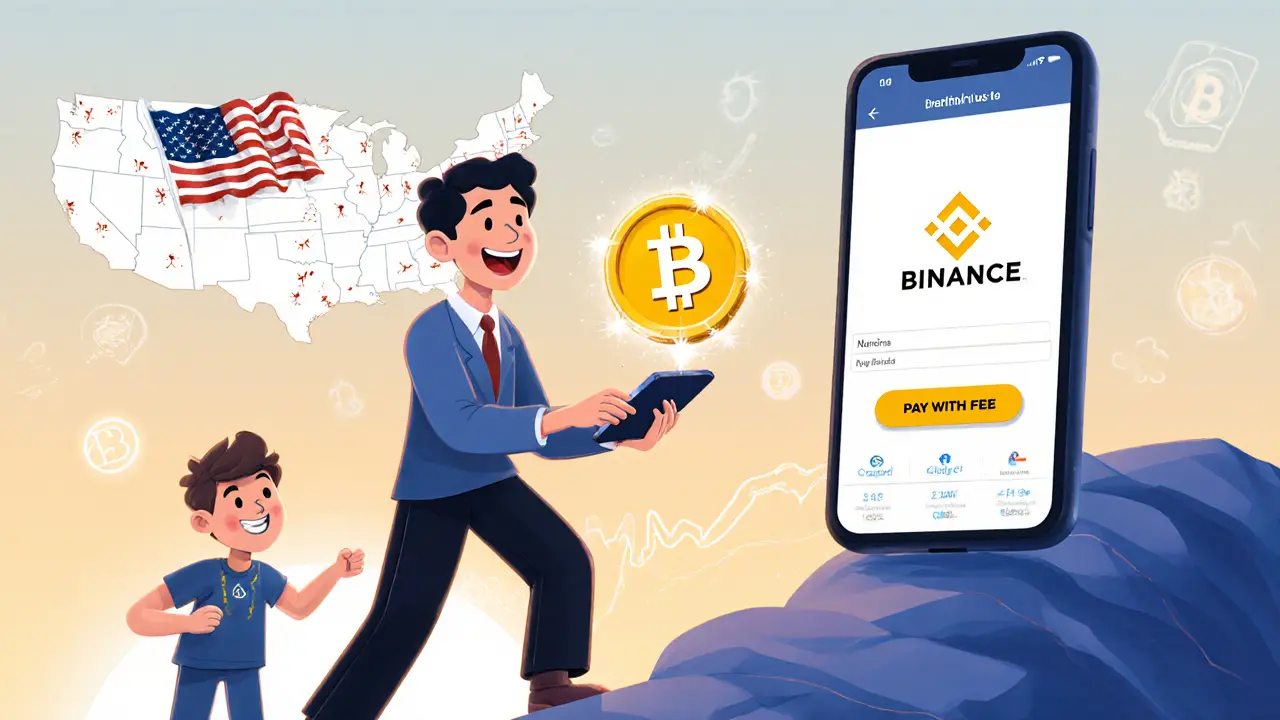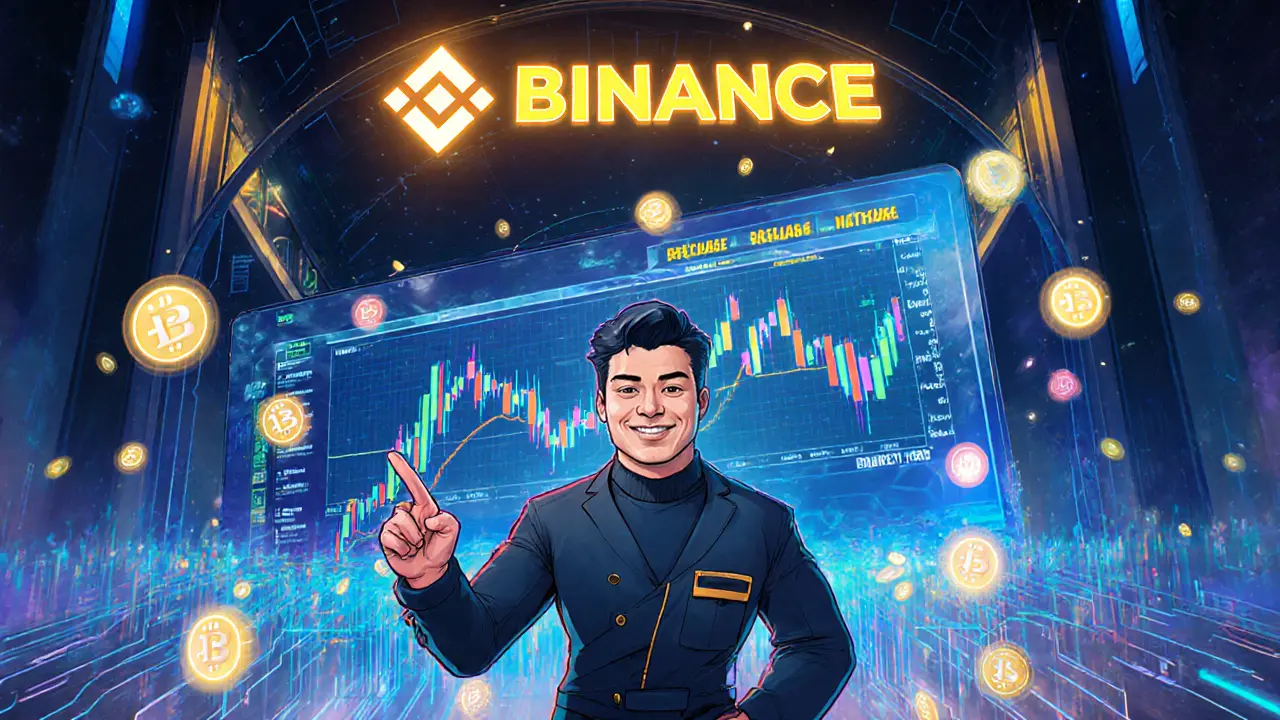Binance Fee Calculator
Your Estimated Binance Trading Costs
Enter your details and click "Calculate My Potential Savings" to see your estimated costs and potential savings.
When you hear the name Binance is a global cryptocurrency exchange launched in 2017 by Changpeng Zhao (commonly known as CZ). With more than 168million registered users and a daily trading volume around $30billion, it’s the go‑to platform for anyone serious about crypto. This review breaks down what Binance actually offers, how safe it is, how its fees compare, and whether the regulatory chatter should keep you up at night.
Quick Summary
- Low‑fee spot trading (0.1%/0.075% with BNB) and deep liquidity make it ideal for active traders.
- Security mixes hardware 2FA, cold‑wallet storage (≈95% of assets) and the SAFU insurance fund.
- Regulatory pressure is rising in the U.S., Europe (MiCA) and Asia; Binance US operates under tighter KYC rules.
- Advanced tools - futures, options, margin, staking, NFT marketplace - can overwhelm beginners.
- Compared to Coinbase and KuCoin, Binance wins on fees and volume but lags on user‑friendly onboarding.
Core Features You’ll Use Every Day
Binance isn’t a single product; it’s an ecosystem. The most used sections are:
- Spot Trading: Over 350 crypto pairs, instant crypto‑to‑crypto swaps without a stablecoin bridge.
- Derivatives: Futures (up to 125× leverage), options and perpetual contracts for seasoned traders.
- Margin Trading: Borrow against holdings to amplify gains (or losses).
- Staking: Earn weekly rewards on 22 supported tokens. Service fees range from 9.95% to 39.95% of the reward.
- Web3 Services: NFT marketplace, launchpad for token sales, Visa debit card, and AI‑powered trading bots introduced in May2025.
All features sit behind a unified account, so you can move from spot to futures with a single click. The learning curve varies - you’ll likely need 2-4weeks to feel comfortable with basic trading, while mastering derivatives can take months.
Fee Structure Explained
Binance’s fee model is tiered by 30‑day trading volume and by whether you pay fees with its native token BNB. The baseline spot fee is 0.10% for makers and takers. If you hold BNB and enable the “pay with BNB” option, you get a 25% discount, dropping the effective fee to 0.075%.
Futures fees start at 0.02% (maker) and 0.04% (taker), also discountable with BNB. Compared with Coinbase (0.50%-0.60% spot fee) and KuCoin (0.10%-0.20%), Binance is the cheapest for high‑volume traders.
Security Measures and the SAFU Fund
Security is the biggest trust factor for any exchange. Binance employs:
- Hardware‑based two‑factor authentication via YubiKey.
- Google Authenticator and optional SMS verification.
- Cold‑wallet storage for roughly 90‑95% of user assets.
- Regular penetration testing and a bug‑bounty program.
In 2019 the platform suffered a $40million hack, but the loss was covered by the Secure Asset Fund for Users (SAFU). SAFU acts as an insurance pool, currently holding billions of dollars to reimburse users in future incidents.
Experts from Security.org praise the cold‑wallet strategy but warn that compromised email accounts can still lead to unauthorized withdrawals if 2FA is not properly secured.

Regulatory Landscape - What’s Changing?
Since 2021, regulators in the U.S., Europe and Asia have kept a close eye on Binance. The U.S. Justice Department launched a tax‑compliance probe, prompting the creation of Binance.US with stricter KYC/AML policies.
In Europe, the Markets in Crypto‑Assets (MiCA) regulation, effective early 2025, limits anonymous trading to €1,000 per month and forces detailed reporting of token offerings. Binance has adjusted its onboarding flow for EU users, but the company still faces uncertainty about future licensing.
For most retail traders outside high‑risk jurisdictions, the platform remains operational. However, if you’re based in the U.S. or a heavily regulated EU country, expect longer verification times and occasional account freezes during market spikes.
How Binance Stacks Up Against Competitors
| Feature | Binance | Coinbase | KuCoin |
|---|---|---|---|
| Spot fee (base) | 0.10% | 0.50% - 0.60% | 0.10% - 0.20% |
| Derivatives | Futures, options, perpetuals | No native futures (Coinbase Pro limited) | Futures (limited pairs) |
| Liquidity (24‑h volume) | $30B | $5B | $1.8B |
| Staking options | 22 tokens, weekly payouts | Limited to a few major coins | 15+ tokens, monthly payouts |
| Regulatory compliance | MiCA‑compliant, US‑focused Binance.US | Licensed in 30+ jurisdictions | Less regulated, higher risk of delistings |
| Mobile app rating (Google Play) | 4.6 ★ | 4.4 ★ | 4.3 ★ |
Key takeaways:
- If you need the lowest fees and deepest order books, Binance wins hands‑down.
- Coinbase shines for beginners who value a clean UI and extensive regulatory licensing.
- KuCoin offers a broader selection of niche altcoins but less liquidity and higher fees.
Step‑by‑Step: Getting Started on Binance
- Visit binance.com and click “Register”. Use a strong, unique email address.
- Complete the KYC process - upload a government ID and a selfie. Expect verification within 10minutes for most users.
- Enable 2FA. Choose a YubiKey for the highest security, or Google Authenticator for a free alternative.
- Deposit funds. You can transfer crypto from another wallet or use a fiat P2P gateway (credit card, bank transfer, or local payment method).
- Convert a small portion of your portfolio to BNB if you plan to trade frequently. Activate the “Pay with BNB” option in the fee settings to unlock the 25% discount.
- Start with a simple market order on a high‑liquidity pair like BTC/USDT. Once comfortable, explore limit orders, stop‑losses, and finally, futures if you understand the liquidation mechanics.
Remember: never risk more than you can afford to lose, especially on margin or futures. Use the “isolated margin” mode to protect the rest of your account.
Common Pitfalls and How to Avoid Them
- Account freezes during high volatility: Keep a verified phone number and backup 2FA codes. Contact support via the live‑chat widget; response times are usually under 24hours.
- Withdrawal delays on new devices: Pre‑authorize trusted devices in the security settings to speed up future withdrawals.
- Tax reporting headaches: Use Binance’s “Export Trade History” CSV and feed it into tax software that supports crypto‑to‑crypto trades, such as CoinTracker or Koinly.
- Unexpected token delistings: Follow Binance’s announcement channel; tokens are usually delisted with a 30‑day notice, giving you time to withdraw or convert.
Is Binance Right for You?
Ask yourself these quick questions:
- Do you need the lowest possible fees and the deepest order books? Yes → Binance.
- Are you a complete beginner scared of complex UI? No → consider Coinbase first.
- Do you trade futures, options, or want to stake a variety of tokens? Yes → Binance’s ecosystem covers it.
- Are you based in a jurisdiction with strict crypto rules (U.S., certain EU countries)? Check Binance.US or look for local licensing status.
Overall, Binance is a powerhouse for active traders who can handle a feature‑rich platform and stay on top of regulatory updates.

Frequently Asked Questions
Is Binance safe after the 2019 hack?
Yes, Binance has significantly upgraded its security. Over 90% of assets are kept in cold wallets, and the SAFU fund reimbursed the 2019 loss. The platform now requires hardware or app‑based 2FA and runs regular security audits.
How do I lower my trading fees on Binance?
Hold Binance Coin (BNB) in your account and enable the “Pay with BNB” option. This gives you a 25% discount, bringing the base spot fee from 0.10% down to 0.075% per trade.
Can I use Binance in the United States?
U.S. residents should sign up on Binance.US, which complies with U.S. AML/KYC rules. The main Binance.com site still accepts U.S. IPs for certain services, but full trading features may be restricted.
What’s the best way to report my Binance trades for taxes?
Export your transaction history from the “Account → Transaction History” page as a CSV, then import it into a crypto‑tax software that supports Binance’s format. Make sure to include crypto‑to‑crypto trades, as they are taxable events in many jurisdictions.
How does Binance’s staking work?
You lock up supported tokens for a minimum of 7days. Rewards accrue daily and are paid out weekly. The service fee ranges from 9.95% to 39.95% of the reward, depending on the coin.


Andy Cox
September 12, 2025 AT 07:11Binance keeps rolling out features and the fees still look cheap
Courtney Winq-Microblading
September 25, 2025 AT 16:12Scrolling through the fee tables feels like watching a sunrise over a digital sea – the gradients of discount shimmer, and the promise of low-cost trades whispers a subtle invitation to explore deeper waters of the crypto market.
katie littlewood
October 9, 2025 AT 01:13Binance has cemented its position as the go-to exchange for seasoned traders seeking deep liquidity.
The spot fee of 0.10% with a possible 25% discount via BNB is arguably the most competitive in the industry.
Users who venture into futures will notice the maker‑taker spread narrowing to as low as 0.02%/0.04%, which can make a noticeable difference on high‑frequency strategies.
Security protocols have evolved since the 2019 incident; over ninety percent of assets now reside in cold storage, and the SAFU fund stands as a financial safety net.
Two‑factor authentication options range from Google Authenticator to hardware YubiKeys, providing layered protection against phishing attempts.
However, the platform’s UI can feel overwhelming for newcomers, as the dashboard aggregates spot, margin, futures, staking, and NFT sections under one roof.
Navigating this ecosystem effectively often requires a dedicated learning period of two to four weeks before a user feels comfortable executing limit orders without error.
Regulatory scrutiny has intensified across the U.S., Europe, and Asia, prompting Binance to launch region‑specific portals like Binance.US and to adapt KYC procedures for EU compliance.
While the exchange remains operational for most retail participants, occasional account freezes during market spikes are not uncommon, especially for those with incomplete verification.
The fee calculator embedded on the site offers a quick glimpse into potential savings, encouraging users to hold BNB for the discount.
For tax reporting, Binance’s CSV export integrates seamlessly with popular crypto‑tax platforms, simplifying the otherwise cumbersome ledger reconciliation.
Staking rewards, though attractive, come with service fees ranging from under ten percent to nearly forty percent, which can erode yields for less popular tokens.
The introduction of AI‑driven trading bots in May 2025 adds an experimental layer for those seeking automated strategies, though the risk profile remains high.
Compared to Coinbase’s user‑friendly onboarding, Binance demands a more proactive approach to security and compliance.
In summary, the exchange offers unmatched fee structures and liquidity, but it rewards users who invest time in mastering its multifaceted tools.
Jenae Lawler
October 22, 2025 AT 10:14While the article extols Binance’s fee superiority, it neglects to address the hidden cost of custodial risk and the potential regulatory fallout that could render such advantages moot in the near term.
Chad Fraser
November 4, 2025 AT 18:15If you’re already seeing those low fees, consider topping up your BNB balance – that extra discount can shave off a quarter of every trade, turning even modest positions into more profitable ones.
Jayne McCann
November 18, 2025 AT 03:16The fees aren’t the only thing that matters.
Debby Haime
December 1, 2025 AT 12:17Exactly, and beyond the discount, holding BNB also gives you early access to token launches and a bit of voting power on community proposals, which can be a nice added perk for active traders.
emmanuel omari
December 14, 2025 AT 21:18From a security standpoint, the SAFU fund’s multi‑billion reserve, combined with regular third‑party penetration tests, provides a robust safety net that most centralized platforms simply cannot match.